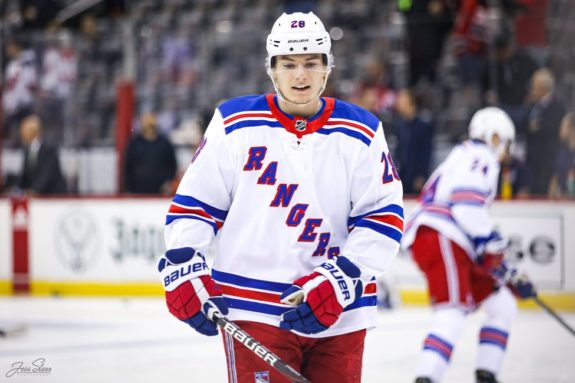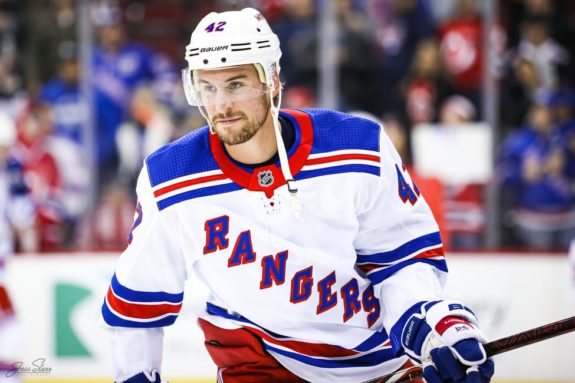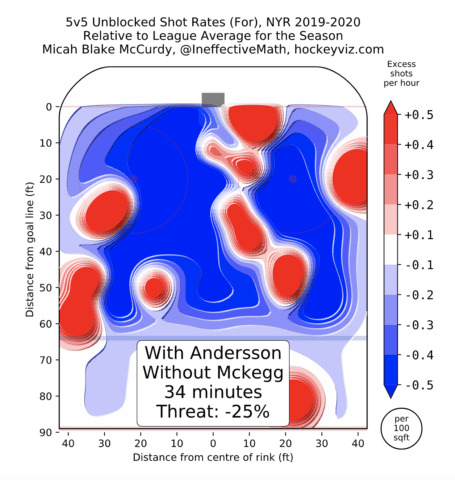It’s just six games into the season, yet New York Rangers fans have their torches lit and pitchforks at the ready to chase head coach David Quinn out of town. The primary reason for this insatiable hatred? Lias Andersson’s deployment as a fourth-line center. Many view the 2017 seventh-overall pick as a viable option at second-line center, despite the lack of experience, speed, responsibility or skill to fill the hole. Instead, Quinn has chosen to stick Andersson on the fourth line with a pedigree of linemates that include Brendan Smith, Micheal Haley, Greg McKegg, or whomever else is victim to the “Quinn Bin.”

Yet, Andersson’s underlying numbers hardly support movement in the lineup. At times, his linemates even outplay him. When he is supported by more skill, his play is still subpar and can’t justify a promotion. His limited time on ice (TOI) and fourth-line fate has much less to do with Quinn’s roster decisions but rather by his own hand.
The Influence of Linemates
Andersson’s five-on-five ice time currently sits at the third-lowest among roster forwards. Only McKegg and Haley have less ice time over the current six-game stretch. That being said, the gap is quite large between the three, as Andersson currently sits at 45:46 5v5 TOI while the other two are under 20 minutes of 5v5 TOI.
Over that time, Andersson has generated just five shots on net but has been doing well at retaining possession of the puck. He’s the only forward to not have a giveaway at 5v5 strength and his five takeaways trail only Kaapo Kakko, Artemi Panarin, and Mika Zibanejad. Unfortunately, Andersson still struggles in possession metrics, as he’s posted a mediocre 42.31 5v5 corsi percentage. That trails both Smith and McKegg. Andersson makes up for his poor Corsi with a 50.58 expected goals forward percentage (xGF%), good for fourth on the team. However, McKegg leads the team in xGF%, Brendan Lemieux is fifth and Smith currently sits sixth.

If Andersson’s linemates were such a massive hindrance on his own game, they’d be posting marginally worse numbers. In reality, his most common linemates have been performing at the same rate as he has, if not better. That being said, Haley is dead last in 5v5 xGF% and has been a non-existent force in the lineup. His possession metrics trail only Chris Kreider on many accounts. If these numbers tell anything, it’s that McKegg and Andersson have played well when paired together. Splitting them up may not be the answer to overcoming Andersson’s woes.

In fact, Andersson has actually played significantly worse when playing without McKegg. The numbers become even more skewed when Andersson is playing without Lemieux, both in his own end and in the offensive zone. His linemates are far from the cream of the crop of the Rangers roster, but they’ve done more than simply drag down his play.
Struggles in the Dot
Andersson’s most telling hindrance is his inability to win faceoffs, especially in Quinn’s system. The 21-year-old shifted between center and winger last year, following his lack of consistency in the dot. With Filip Chytil in the minors, Andersson was given the opportunity to return to his natural center position. Unfortunately, his faceoff percentage is still absolutely dreadful. His 37.50% faceoff rate is last among the Rangers’ centers, and what’s even more telling is that Brett Howden, Ryan Strome and Zibanejad all post rates over 50%. In fact, Andersson’s rate in the dot is amongst the lowest in the league for centers with 30 or more faceoff attempts. His current percentage puts him with talent such as Valtteri Filppula, Riley Nash, and Cody Glass.
What makes his faceoff percentage even more important is that he starts in the defensive zone more than any other area on the ice. Thus far, Andersson has faced 25 defensive zone faceoffs, 20 in the neutral zone, and just five in the offensive zone. If we apply his current faceoff win rate to those current numbers, he’s winning just about nine faceoffs in the defensive zone. Immediately losing possession in his own zone at that rate is a telling sign that he still can’t be held responsible of top-six line duties.
Quinn’s promise of increased ice time for Andersson will come in time, but it’s a two-way street. He also has to play well enough to warrant that decision, even if it’s on a rebuilding squad. Quinn is adamant on earning your roster spot, hence why Kakko has yet to see time on the first line and why Chytil is in the minors. Andersson’s training camp was good enough to get him on the roster, but now it’s time to for him to prove he can be of more use throughout the lineup. The decision inevitably falls to the head coach, but his fate lies squarely within his own hands.